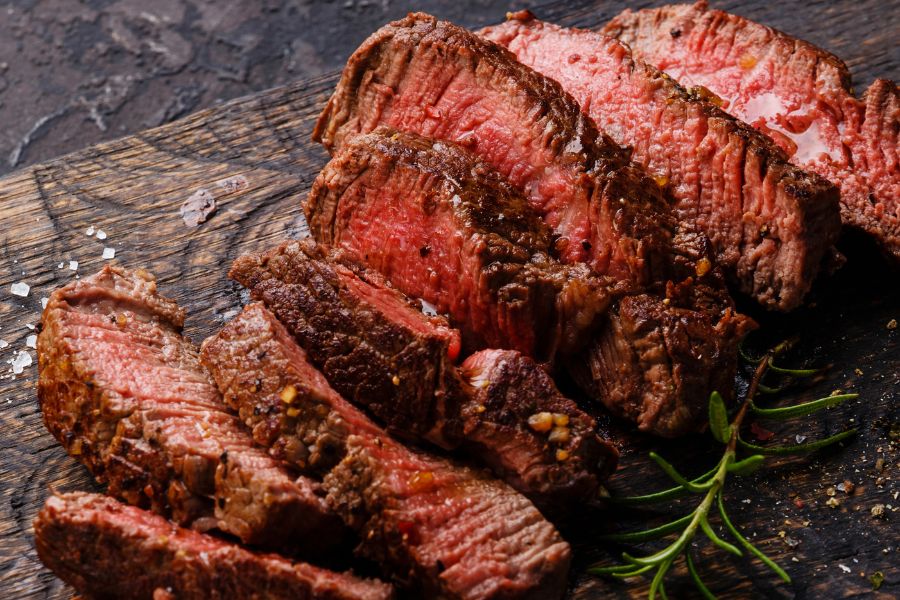How to tell if a steak is bad? The steak will feel slimy, change color, or smell bad.
As someone who has worked in the restaurant industry for a long time, food safety is very important to me. I have learned all the signs of whether or not meat has gone bad and I am here to share this knowledge with you.
In this post, I will cover the most important signs, the significance of them, and other tips on food safety. Let’s begin!

Here are the telltale signs that you have a rotten steak on your hands:
OK, now this should seem like a fairly obvious point – don’t eat food when the expiry date has passed by. However, like many, you are probably aware that the sticker on your packaging isn’t actually the “use by date” but rather the sell by date.

This is the date that the store has to sell the meat by or get rid of it. This is a way of ensuring that they don’t get blamed for a bout of food poisoning.
In reality, the use by date is a little past the sell by date – but when it comes to fresh steak or fresh meat, you do not have much wiggle room here. As long as the meat has been stored at an appropriate temperature you may be able to still use it a day or two past its prime.
This, however, is only as long as you don’t observe the following signs:
The biggest indication that you have a bad steak is that it has a slippery or sticky feel to it. In short, it feels slimy. This is an indication that bacteria has been growing on it for a while and that there is too much for it to be safe to eat.
You should know that spoiled steak may not necessarily smell. Or, it may not always be noticeable because raw meat doesn’t smell that great to begin with. This is especially true for dry aged steaks. A dry aged steak can smell a little unusual, almost cheesy but that’s just how it needs to smell.
Still, if the smell is off or rancid – or there is a pungent odor or it just no longer smells like regular meat, it is time to toss it.
Another way to tell if steak is bad is to look at the color. It should be a healthy pink or red color. Poor signs are if there are tinges of yellow, green, or anything that looks like mold.
Now, I am often asked:
Can you eat a steak if it turns brown?
This is a bit of a confusing thing. This is because when meat is exposed to oxygen, it turns brown due to a component called metmyoglobin. Therefore, even perfectly good steak may appear brown but be safe to consume.
This is why it is a good idea to first consider the expiration date, feel of the steak, and then the odor as well before coming to a conclusion. You should also check that the steak has been stored correctly for the entire time.
These symptoms also hold up for other types of steak such as tuna steak.
Related Reading
So, what if you are dealing with cooked steak – what are the signs, then?
Well, it is pretty much the same indicators. Except here, you are most likely to notice an unpleasant or off smell. The next thing that you may observe is that there is a change in color. You may see discoloration or moldy sections.
If you notice any mold, avoid sniffing the meat. You may inhale the spores.
You should also think about when the meat went into the fridge – how long ago was that? At most, cooked meat is only good for two or three days after preparation.
Related Reading
How long will frozen steak stay good for?
Technically, steak can stay good to eat for up to 8 months at a time in the freezer. This does depend, though, on how the steak was kept and stored before this. For instance, if the fresh steak was kept in the fridge until it was frozen, then there is a good chance it will be safe.
On the other hand, if it was left out on the counter for hours on end before being frozen, then the meat may have already begun to go bad. As some bacteria and spores can survive in very cold temperatures, once the steak thawed, it may still be bad.
You should also be mindful of the fact that frozen meat will only be good if the freezing temperatures have been maintained. If the meat has been out of the freezer for any period of time or if there has been a power outage, it may not be as safe to eat.
Another thing to keep in mind is that just because frozen steaks can be kept for 8 months, doesn’t mean that it should be. After the 4 month mark, the taste and texture will probably be compromised. Thus, it is best to eat it before then.
Related Reading
I know what you are thinking – what is the worst that can happen if you were to eat steak that may be slightly spoiled?
Well, the biggest problem is the risk of foodborne illness. Some of the symptoms may include:
The severity of the symptoms can vary from one person to another. For some people, the symptoms may be quite mild, especially in the case of slightly spoiled meat. If you have a strong immune system then you may not have such a terrible bout of illness either.
On the other hand, people with compromised immune systems or weaker individuals such as older people and children are at greater risk of severe cases. In some instances, they may even need to be hospitalized.
Basically what I am saying is that it is better to be safe than sorry. Yes, it can be tempting to eat the meat so that you don’t lose out on how much you paid for it. However, it may simply not be worth it.
This is the question that I am asked most of all. Raw steak is bad – there is no doubt about it, but what if you were to heat the meat. Doesn’t heat kill bacteria?
Unfortunately, this isn’t necessarily true. Heat may kill harmful bacteria, but many spores produced by these agents are immune to heat. As such, they can still cause disease even after the steak has been cooked at high temperatures.

Here is what you need to do to keep and store your steak properly:
The first thing that you need to do is to check how long the meat is good for. Then, decide if you will actually cook your steak within this period. If not, it is best to buy your steak later on. This is the best way to avoid spoiled food.
When shopping for steak, make sure to head straight home after purchasing it. What’s more, place the meat in a cooler bag to ensure that it stays at the proper temperature throughout. This is especially important in the summer or if you have a long drive home.
Your meat is probably not wrapped too well at the store or the butcher shop. In fact, it may only be wrapped in pink paper. If this is the case, make sure that the steak is tightly wrapped or placed in a vacuum sealed package. A Ziploc container should do the trick.
Remember to always write the expiration date and the date that meat went into the freezer. This ensures that you prepare the refrigerated steak before it goes bad.
If you aren’t going to be using the steak within a day or two, I would suggest freezing it for long term storage. First, place it in a large freezer safe bag and squeeze out all the air out of it. This will help to avoid freezer burn. Seal tightly.
Make sure to write the date that the steak is going into the freezer.
When you defrost the steak, remember to never leave it out on the counter for more than an hour at a time. Either let it thaw in the refrigerator or place the steak – in its wrapping – in cold water. Keep replacing the water every hour to hurry up the process. Your steak should be fully defrosted in a couple of hours.
Here is what you can tell if steak is bad or not. And, you can also find some useful tips to ensure that you end up with a delicious steak that is safe to eat! So, keep all this information and the pointers in mind at all times!